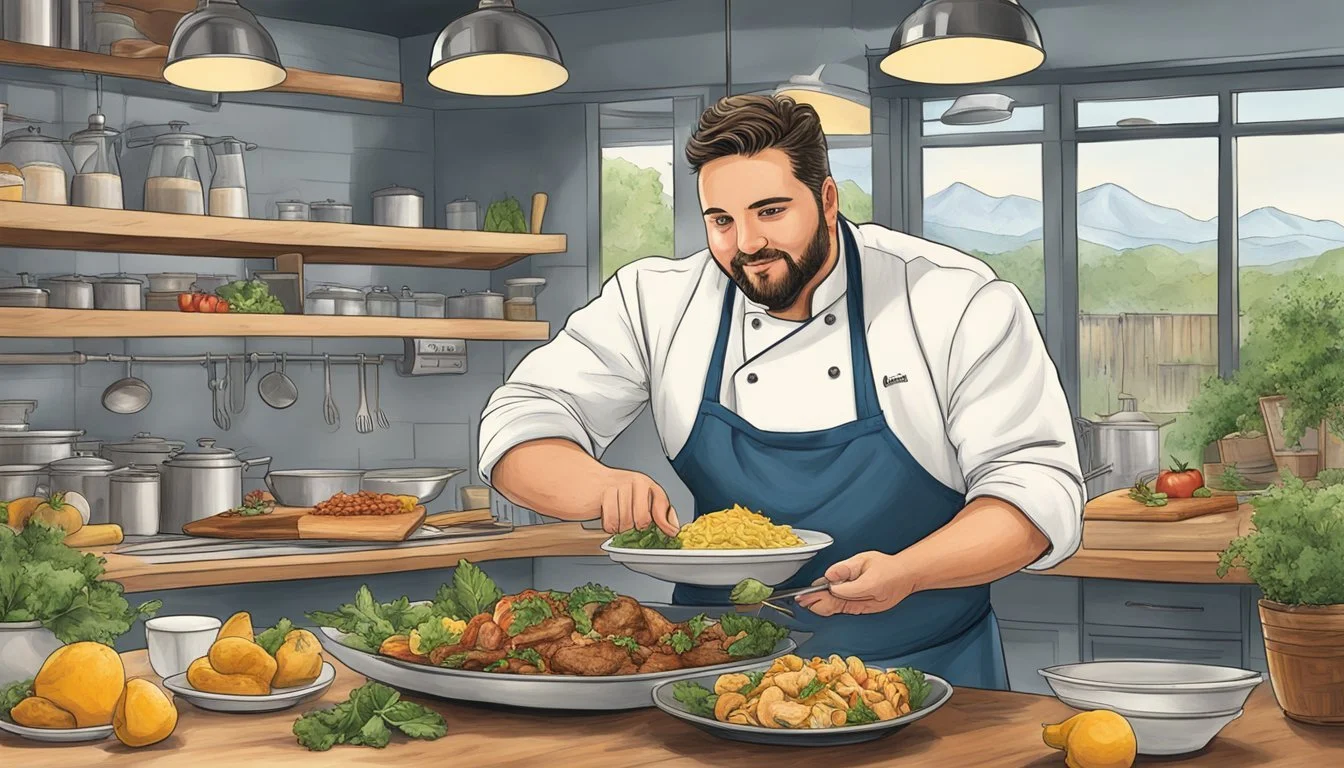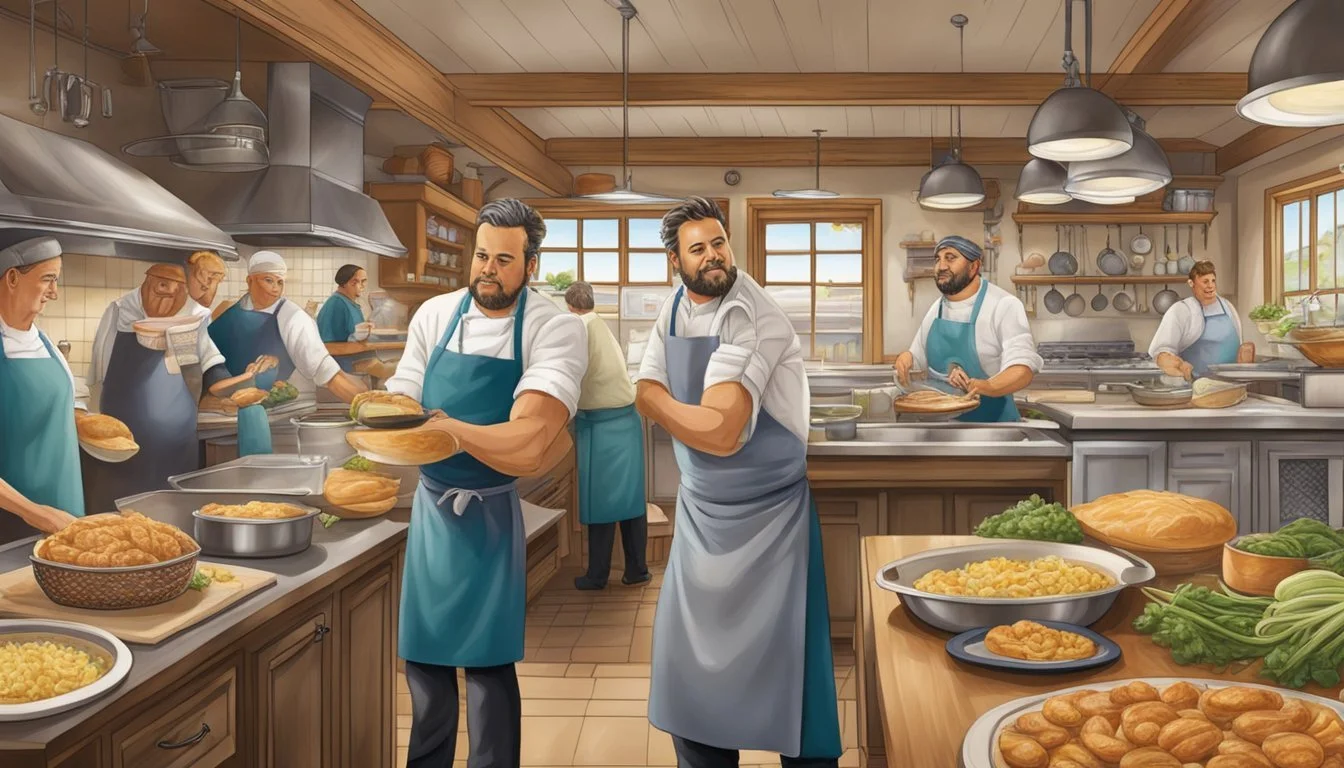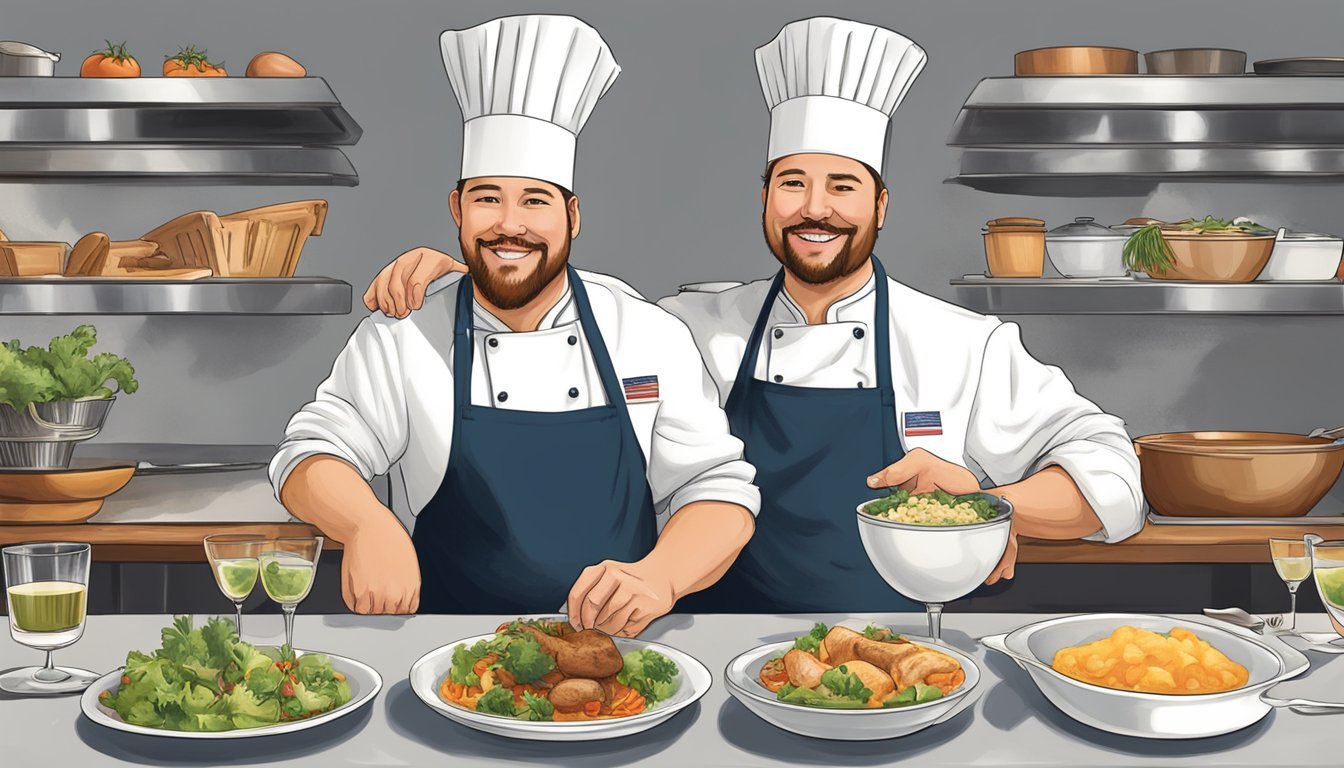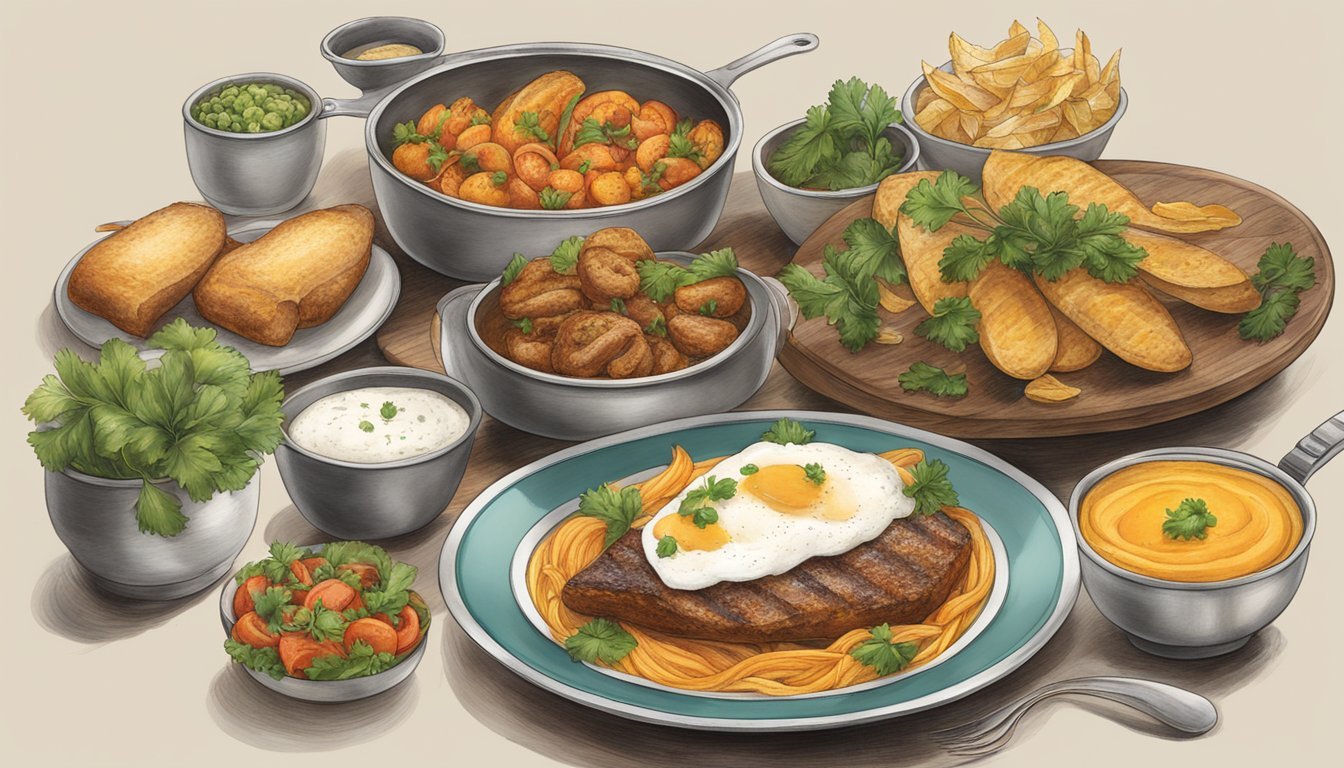The Influence of German Cuisine on Texas Celebrity Chefs
Culinary Crossroads Explored
Texas' culinary scene is a vibrant tapestry woven with diverse ethnic influences, where the robust flavors of German cuisine (What Wine Pairs Perfectly With German Cuisine) have left a notable impression. This influence has even extended to the palates and menus of Texas' celebrity chefs, who often incorporate traditional German tastes into their celebrated dishes. The history of German settlers in Texas dates back to the 19th century, bringing with them an array of culinary techniques and a fondness for hearty ingredients, such as sausages, bread, and beer, which have since become staples in Texan cooking.
Celebrity chefs in Texas often pay homage to this German heritage by reinventing classic dishes with a modern twist, maintaining a connection to the state's gastronomic roots. This fusion of German and Texan flavors is a testament to the lasting impact of German immigrants on the state's food culture and how it continues to shape contemporary cuisine. The integration of these cuisines is not simply about blending cooking styles, but also about preserving and celebrating the rich, cultural narrative that food represents.
As food enthusiasts delve into the menus of these chefs, they encounter dishes that reflect a unique culinary dialogue between traditional German fare and the bolder, rustic flavors of Texas. This synthesis not only enriches the state's food identity but also positions Texas at the heart of a culinary crossroads, showcasing the power of food as a unifying cultural force.
Historical Context of German Influence in Texas
In the mid-1800s, the Adelsverein, also known as the Society for the Protection of German Immigrants in Texas, facilitated a significant migration of German settlers to the Lone Star State. Under the leadership of notable figures such as Prince Carl of Solms-Braunfels and John O. Meusebach, these European settlers established strong communities in Central Texas. New Braunfels and Fredericksburg, in the heart of Texas Hill Country, are prime examples of towns that embody the German influence.
The settlers adapted to the local resources and integrated their culinary tradition with the regional flora and fauna. German food traditions, especially those involving meat processing and beer brewing, took root in Texas and evolved to become a staple of the local cuisine. Smoking and curing techniques brought over by Germans were especially influential, leading to the development of the Texas German sausages which are celebrated at events like Wurstfest in New Braunfels.
Year Event 1842 German immigrants begin settling in Central Texas 1845 Establishment of the city of New Braunfels 1846 Founding of Fredericksburg by German pioneers 1850s-1860s Expansion of German communities throughout Hill Country
These immigrants forged a hybrid culture, blending their European heritage with the Texan environment. The traditions and culture they instilled continue to influence Texas to this day, including an impact on the style and flavors utilized by celebrity chefs, who often pay homage to these historical roots through their culinary creations.
German Culinary Traditions in Texas
German culinary influence in Texas can be observed in various aspects of its food culture, with a significant impact on the flavors and techniques embraced by Texas celebrity chefs.
Sausages and Meat Dishes
In Texas, the German legacy is exquisitely represented in the sausage-making tradition. German settlers introduced sausages, which have become staples in the Texan diet. Artisanal varieties like bratwurst and knockwurst sit alongside local experiments that infuse Texan spices and smoked meats (What wine goes well with smoked meats?) techniques. Barbecue pits in Texas frequently feature sausages that celebrate this German heritage, often served with sauerkraut or cream gravy, paying homage to their origins while flaunting a distinct Texan twist.
Bread and Pastries
Pretzels, both savory and sweet, bear witness to the German influence on Texan baking. These intertwined delights retain the traditional German methods but are often served alongside Texan dishes. Beyond pretzels, pastry shops and bakeries offer a vast array of bread and desserts that culminate from a blend of German recipes and Texan flavors. One can easily find pastries filled with local fruits or spiced according to Texan palates, embodying the German-Texan culinary fusion.
Beer and Beverages
Beer plays an integral role in German culture, and this remains true within Texas where many celebrity chefs have found ways to incorporate this beverage into both consumption and culinary practices. Texan microbreweries and beer gardens often feature beers reminiscent of those found in Germany, celebrating events like Oktoberfest. Moreover, these German-style beers are frequently employed in the creation of savory dishes, such as beer-battered schnitzel, or used in braising liquids for meats, adding a layer of depth to the traditional Texan barbecue.
Influence on Texas Celebrity Chefs
In the landscape of Texas gastronomy, German culinary traditions have been instrumental in fostering a unique approach among local celebrity chefs. They often incorporate German techniques and flavors into their American South-inspired dishes.
Integration of German Techniques
German culinary techniques, particularly in baking and meat preparation, have become a foundation for several Texas chefs. Hugo Ortega, known for his authentic Mexican restaurants, acknowledges the precision and depth of European methods. At places like Scholz Garten, the oldest operating beer garden in Texas, German techniques in food preparation and service have been maintained since their establishment by German immigrants in the 19th century.
Creative Fusions with Texas Cuisine
Celebrity chefs in Texas, such as Tim Love, are acclaimed for infusing German elements into their signature dishes. Love’s renowned restaurant, Lonesome Dove Western Bistro, exhibits a blend where the robustness of Texas meats meets the subtleties of German-inspired flavors. Similarly, Tyson Cole, famed for his restaurant Uchi, demonstrates creativity in combining global influences, a principle that can trace its roots to the integration of German flavors.
Prominent Chefs with German Inspirations
Hugo Ortega and Tyson Cole, both James Beard Award winners, exhibit in their culinary art the impact of global influences mingling with Texan culture. Ortega’s journey involved mastering European skills that significantly shaped his cooking style, while Cole's precision at Uchi aligns with the detail-oriented German approach. Their status as leaders in the culinary field underscores the profound influence of diverse heritages on Texas cuisine.
German Food's Role in Texas Culture
German cuisine has left an indelible mark on Texas culture, mainly through festivals and community events that celebrate culinary traditions, as well as family-owned German restaurants that serve as cultural and culinary cornerstones.
Festivals and Community Events
Wurstfest in New Braunfels stands out as a notable example. Drawing over 100,000 attendees, this festival transforms the town into a showcase of German heritage for ten days every November. Visitors immerse themselves in the festive atmosphere of a Bavarian beer garden, relishing a variety of sausages and beers that reflect the authentic German tradition.
Date: November
Location: New Braunfels, Texas
Offerings: Sausage, Beer, German Traditions
Attendance: >100,000
The role of these events extends beyond mere celebrations; they serve to maintain a German identity within the Texan cultural mosaic.
Family-Owned German Restaurants
Family-owned German restaurants are vital in preserving the German gastronomic legacy in Texas. Establishments like Kuby's in Dallas have been instrumental in bringing traditional German flavors to the region. Started by German immigrants, these restaurants are often generational establishments where recipes and culinary techniques are passed down, ensuring authenticity and continuation of the cultural identity.
Kuby's Sausage House
Location: Dallas, Texas
Founded: 1961
Specialties: Traditional German Recipes
Through both festivals and dining experiences, German food has become more than just cuisine in Texas—it's a testament to the enduring influence of German culture in shaping local communities and culinary scenes.
Texas Cities and Their German Culinary Scenes
German cuisine has carved out a distinctive niche within Texas's culinary landscape, with several cities hosting vibrant scenes that blend traditional German influences and local tastes.
Austin's Diverse Food Landscape
In Austin, the German culinary impact is significant in the diverse range of offerings, particularly in the form of sausages, pretzels, and schnitzels. It's a city where old-world flavors meet contemporary dining, giving rise to authentic German eateries and fusion menus that draw in food enthusiasts.
San Antonio's Rich History
San Antonio's love affair with German cuisine is embodied in dishes like barbacoa, which has been locally adapted from traditional practices. German techniques and Texas barbecues combine to make the culinary tradition here both rich and historically layered, offering a unique taste that is distinctly Texan with German roots.
Houston's Melting Pot
Houston epitomizes cultural fusion, with German cuisine taking its rightful place alongside other international flavors. This city's food scene is known for its dynamic and innovative character, where German dishes are skillfully interwoven with Southern and Tex-Mex influences, creating a diverse culinary tapestry.
Dallas and Fort Worth's Modern Twist
Dallas and Fort Worth have embraced German influence with a modern twist, incorporating German-style cooking into the high-end dining scene. From gourmet sausages to artisan pretzels, chefs in these cities are redefining traditional German fare by infusing it with local Texan flair and ingredients.
Modern Adaptations and Food Fusion
In the Texas culinary scene, there exists a unique blending of German and Texan influences, leading to innovative dishes that reflect a deep appreciation of both cultures' gastronomic histories.
Tex-Mex and German Combos
Texas chefs infuse classic Tex-Mex fare such as tacos, enchiladas, and fajitas with traditional German elements. For example, tamales filled with a spiced mixture of smoked sausage, a nod to German smoking techniques, have gained popularity. Chili con carne could feature German beer in the braising liquid, adding depth of flavor. Variations of Tex-Mex dishes regularly incorporate corn tortillas as a foundational element and filling, sometimes substituting standard fillings with savory German-inspired meats.
Taco Innovations:
Smoked Bratwurst filling
Sauerkraut as a topping in place of traditional salsas
Enchilada Twists:
Sausage and potato filling
Mustard-infused enchilada sauce
Contemporary German-Texas Dishes
Chefs continue to explore the fusion of German and Texan cuisines beyond the Tex-Mex spectrum. These creative endeavors often result in new specialty dishes that honor the integrity of both culinary traditions. A prime example would be a German-style schnitzel made with Texas-sourced ingredients, or a traditional sauerbraten that's been given a Southwestern flare through the incorporation of regional spices and flavors.
New Specialties:
Schnitzel with a Texas pecan crust
Sauerbraten with a chipotle-infused marinade
Cultural Exchange and Immigrant Contributions
Texas's culinary scene is a vibrant tapestry woven from the diverse strands of migrant cultures, particularly the flavors brought by German and Czech immigrants that have been intricately integrated by celebrity chefs within the state.
Mexican and Central European Influences
The culinary landscape of Texas is heavily marked by Mexican and Central European flavors, a testament to the wave of immigrants who have settled in the state. Mexican migrants introduced a rich palette of spices, cooking techniques, and staple ingredients. Concurrently, German immigrants contributed their sausage-making expertise and love for pastries, establishing a food culture in Texas that is rich with European heritage. These culinary inputs were not one-sided; they merged with local Texas traditions to create new, distinct flavors that are uniquely Texan.
Mexican Contribution: Spices (e.g., chili powder, cumin), techniques (e.g., grilling, smoking meat).
Central European Contribution: Sausages (e.g., bratwurst, kielbasa), breads (e.g., pretzels).
Culinary Syncretism in Texas
In Texas, celebrity chefs are ambassadors of a uniquely synthesized culinary tradition that marries Mexican zest with Central European heartiness. This fusion can be observed in festivals like the Wurstfest in New Braunfels, highlighting German food practices integrated into Texan traditions.
Culinary Fusion Examples:
Tacos with Bratwurst: A bold integration of soft tortillas with spiced, German-style sausage.
Barbecue Techniques: Utilizing Central European methods to smoke meats, while incorporating Mexican spice rubs and marinades.
By honoring the contributions of both Mexican and Central European migrants, Texas's celebrity chefs continue to shape a food culture that is both internationally diverse and intimately local.
Industrial and Agricultural Impact
The German influence on the Texan culinary scene has marked its presence in the industrial and agricultural sectors, particularly through the brewing industry and diverse agricultural practices that supply food ingredients.
Brewing Industry in Texas
The brewing industry in Texas, with its roots in German traditions, has significantly contributed to the state's economy. German immigrants brought with them the craft of beer making, which has since flourished. Today, Texas is home to a burgeoning craft beer scene with numerous microbreweries and beer festivals like Wurstfest. Beer production has become an emblematic industry in Texas, supporting local economies and creating jobs.
Agriculture and Food Supply
Texas’s agriculture has been enriched by German customs, which introduced a variety of vegetables and techniques to local farming. The state's agricultural diversity supports a plethora of ingredients essential for both traditional BBQ recipes and German dishes. Texas farmers continue to supply barbecue joints with high-quality meats and local eateries with fresh produce, ensuring that the fusion of flavors remains authentic and of high standard. The synergy between agriculture and the food industry is pivotal, sustaining the culinary landscape that celebrity chefs draw from.
Regional Variations Within Texas Cuisine
Texas cuisine displays an exceptional variety influenced by its vast geography and diverse cultural heritage. In the western part of the state, West Texas cooking embodies the spirit of cowboy culture with hearty, meat-centric dishes. This area is known for its barbecued brisket and beef ribs, which are often slow-cooked over open flames.
Moving to Central Texas, the German influence is pronounced, where one will find sausages and meats smoked with a precision akin to the meticulousness of European traditions. Central Texas barbecue, particularly, has evolved into an art form influenced heavily by the German legacy of meat-smoking.
El Paso and the surrounding areas exhibit a blend of flavors where Texan meets traditional Mexican cuisine, offering dishes such as chili con carne and fajitas that have become synonymous with the broader Tex-Mex culinary category.
The Gulf Coast region introduces seafood into the mix, with fresh catches from the Gulf of Mexico utilized in various ways. Cajun influence is noticeable, as Texas shares a border with Louisiana. The Gulf Coast is known for its creole flavors, gumbo, and crawfish boils that are indicators of this crossover.
Region Culinary Influence Typical Dish West Texas Cowboy culture, meat-centric Barbecued beef ribs Central Texas German, meat-smoking Smoked sausages El Paso Mexican, Tex-Mex Chili con carne Gulf Coast Seafood, Cajun Gumbo, crawfish boils
These regional variations are a testament to Texas's rich tapestry of culinary traditions, with each area offering a distinct flavor profile that contributes to the state's gastronomic diversity.
German-Texan Food During Crisis
During trying times, such as a pandemic, the resilience of a cuisine can shine through. German-Texan food, with its hearty and comforting qualities, played a significant role in offering stability and a sense of normalcy.
Food Resilience During the Pandemic
German-Texan cuisine proved its resilience amid the pandemic as chefs and home cooks alike turned to traditional recipes known for their durability and sustainability. German influences, notably in sausages and breads, allowed for meals that could be easily preserved and stored, reducing the need for frequent market visits.
Staple Ingredients: Smokehouses preserved meats—chief among them, sausages, which could be stored for longer periods.
Sourdough Bread: Its prolonged fermenting process resulted in longer-lasting bread, a staple during times where fresh produce was hard to come by.
Community Support: Texan chefs of celebrity status utilized these German culinary practices to serve their communities, demonstrating the cuisine's adaptability and sustainability.
The emphasis on smoking and preserving not only catered to the need for food that could withstand shortages but also highlighted the German culinary heritage embedded within Texan culture.
Preservation of Heritage and Traditions
Texas celebrity chefs are at the forefront of preserving the rich German heritage that flavors their cuisine. Festivals such as the Wurstfest in New Braunfels play a central role in this preservation. At these gatherings, chefs showcase the influence of German traditions through food, prominently featuring sausages, a staple inherited from early German immigrants.
The passion for Oktoberfest celebrations is another avenue where chefs honor German cuisine. These events are not just about beer; they are a showcase of authentic dishes and traditional German cooking techniques passed down through generations.
Evident is the impact of German culture on the local architecture. Places like Fredericksburg retain a distinctly German character, with buildings that provide a nod to Texas' European past. Texas chefs draw inspiration from this setting, creating dining experiences that blend traditional German architecture with modern culinary artistry.
The language and dialects of Texas have also been shaped by German influence. Though not as predominant in the culinary scene, they subtly inform the names of dishes and ingredients, preserving the linguistic heritage.
List of German Influence in Texas Culinary Scene:
Sausages: A variety of types rooted in German tradition.
Oktoberfest: Annual celebration, embracing German foods and beverages.
Architecture: Fredericksburg's buildings influence the ambiance of dining establishments.
Language: Dish names and gastronomy terms reflecting German origins.
Chefs are key in preserving German heritage, integrating historical flavors with contemporary tastes, thereby keeping traditions alive in the ever-evolving Texas culinary panorama.
Conclusion
The impact of German cuisine on the landscape of Texan cooking is particularly evident in the state's array of sausages. Not only have Texas's celebrity chefs embraced this gastronomic heritage, but they have also innovated upon it, creating unique takes that complement the traditional Texan barbecue.
In the realm of professional kitchens, one sees the celebration of this culinary fusion at establishments like Franklin Barbecue and Lonesome Dove Western Bistro. They are not mere eateries; they serve as cultural hubs where the essence of German influence and Texan spirit coalesce. These chefs and their iconic restaurants stand testament to the lasting German impact on Texan cuisine.
Festivals like Wurstfest in New Braunfels underline the community's respect and affection for these culinary traditions. Drawing over 100,000 visitors, it embraces German heritage through food and festivity, signaling its importance to Texan identity.
The narrative of German cuisine in Texas is characterized by integration and adaptation, not isolation. Chefs have played a crucial role in this story, preserving authentic methods while simultaneously tailoring them to local tastes and ingredients. Their work honors the history of German settlers, ensuring that their culinary signatures continue to thrive within the vibrant tapestry of Texas cuisine.













